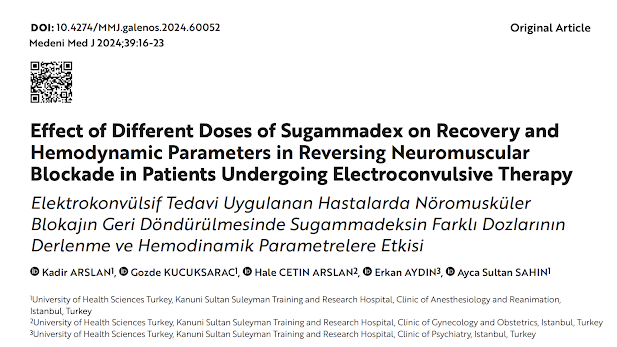Sugammadex Reversal of Rocuronium: New Study From Turkey
Out on PubMed, from authors in Turkey, is this paper:
Effect of Different Doses of Sugammadex on Recovery and Hemodynamic Parameters in Reversing Neuromuscular Blockade in Patients Undergoing Electroconvulsive Therapy.
Medeni Med J. 2024 Mar 21;39(1):16-23. doi: 10.4274/MMJ.galenos.2024.60052.PMID: 38511727

The abstract is copied below:
Objective: This retrospective observational study aimed to investigate the effect of different doses of sugammadex used in reversing neuromuscular blockade in electroconvulsive therapy (ECT) procedures on patient recovery and hemodynamic measurements.
Methods: Anesthesia induction was performed using propofol (1 mg/kg) and rocuronium (0.4 mg/kg). Patients were classified into group 2 (2 mg/kg) and group 3 (3 mg/kg) according to the dose of sugammadex used to reverse neuromuscular blockade. The patient's spontaneous breathing time, eye-opening time, time to comply with voluntary commands, time to reach Modified Aldrete score (MAS) 9, complications, and hemodynamic data were analyzed.
Results: In total, 314 ECT sessions were performed on 46 patients. The average age of the patients was 38.3±12.6 years, and 56.6% (n=26) were male. While the average number of ECTs applied to the patients was 6.8±2.8, the average seizure duration was 28.2±12.7 seconds. The most common diagnosis (32.7%) in patients who underwent ECT was bipolar disorder. The average time to recovery of spontaneous breathing, eyeopening time, time to comply with voluntary commands, and time to reach MAS 9 were found to be significantly lower in group 3 (p<0.001, p<0.001, p<0.001, and p=0.002, respectively). Tooth damage was observed in 0.3% (n=1) and tongue abrasion in 0.6% (n=2) of the cases. Hemodynamic measurements were similar between groups (p>0.05).
Conclusions: Sugammadex used at a dose of 3 mg/kg in ECT procedures significantly reduces recovery times compared with 2 mg/kg. However, both doses can be safely and cost-effectively used to reverse the neuromuscular blockade provided by 0.4 mg/kg rocuronium.
Keywords: Electroconvulsive therapy; anesthesia recovery; neuromuscular blocking agents; rocuronium; sugammadex.
The article is here.
And from the text:
This is a straightforward retrospective study of two doses of sugammadex to reverse rocuronium. IMO, the authors exaggerate the problems associated with succinylcholine in order to justify their study. Succinylcholine should still be the agent used in the vast majority of ECT cases, except where there is a specific benefit to using a non-depolarizing muscle relaxant.
But kudos nonetheless to our Turkish colleagues for this contribution to the ECT anesthesia literature.





Comments
Post a Comment